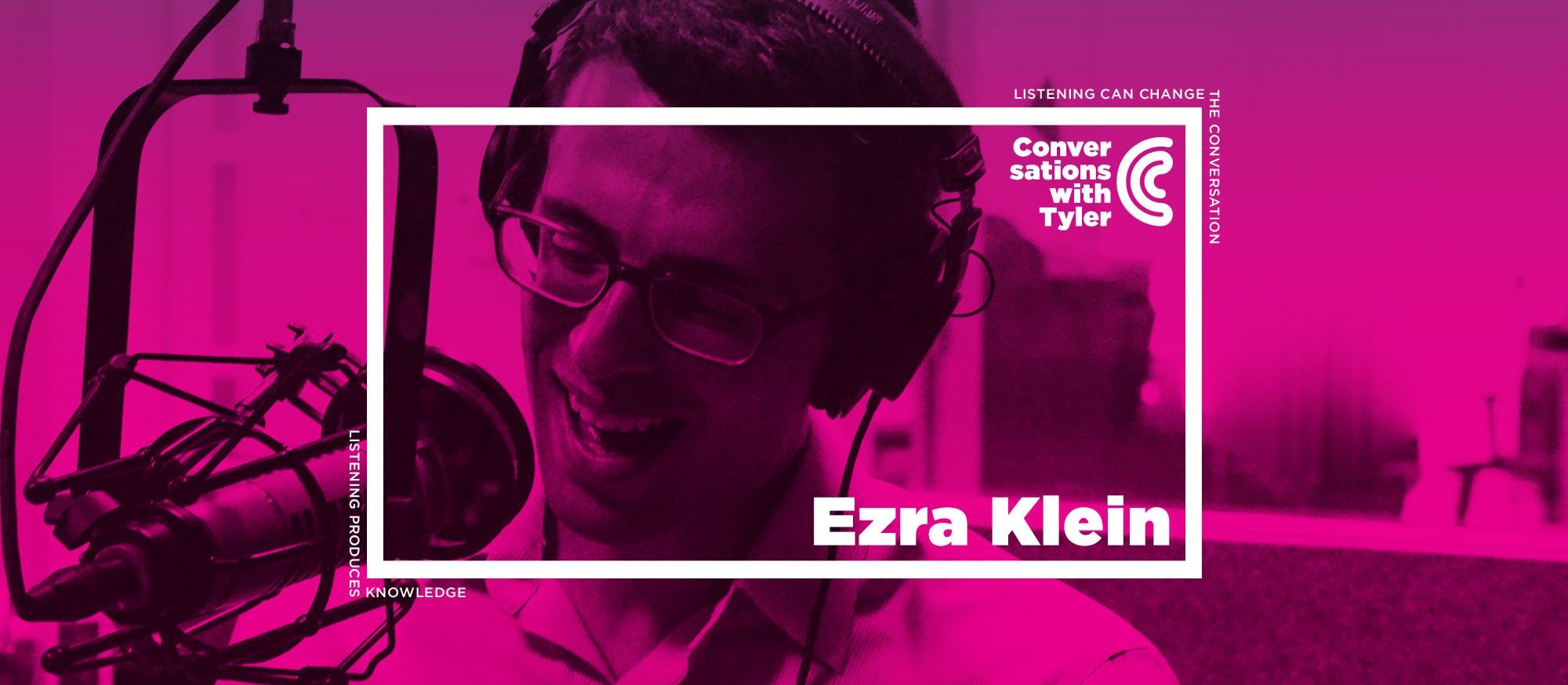Ezra Klein, editor-in-chief of Vox.com, joins Tyler Cowen for a conversation on biases in digital media, the morality of meat-eating, how working for large organizations has changed his worldview, the psychographics of CEOs, what’s missing in public discourse, the most underrated member of the Obama administration, and why you should never follow his lead on what’s good culture.
Watch the full conversation
Read the full transcript
TYLER COWEN: I’m here today with Ezra Klein, media entrepreneur, blogger, health care thinker. Ezra is the creator of Vox.com, which is one of the most important up-and-coming, and indeed, now established media sites. Ezra himself runs a podcast series. He thinks broadly and deeply about everything. And I will stress, as I always do, this is the conversation I want to have with Ezra, not the conversation you want to have with Ezra.
EZRA KLEIN: I like this podcast disclaimer. I’m going to steal it.
[laughter]
On the bias of video and podcasts
COWEN: Let me start with some questions about media. We’ll get to politics, you, and everything else, but different formats in media. So you can do something in print, you’ve been a blogger, you’ve been involved with periodicals, now you do Vox. Vox, to me, seems to be doing more and more video, so let’s start with video.
When you use the medium of video, what is the bias in using video in terms of what kind of material, what kind of message? How does that slant what any site, but including Vox.com, is going to do and be?
KLEIN: It is much more different than I believed it was let’s say two years ago. Before I came to Vox, I used to do a lot of cable news. I was a guest host on MSNBC. I came pretty close to taking a show at some point. You and I spoke during that period.
One thing about cable news is it actually isn’t that different than writing. You are basically writing a script. There are elements, and there’s visual, but you are really writing a script, and you read it aloud. At least, I should say the way I did, it worked that way.
When I started Vox, I had the great fortune to hire a guy named Joe Posner who I met at a media conference and struck me from the second I met him as a real video genius. The reason Vox’s video is great, and I have no compunction saying it’s great because I don’t have all that much to do with it, is because Joe, and Joss Fong, and the rest of that team, they really think about video as its own form in a very different way than I had before.
We will be talking through stories, and I will come to them with something from the site that did really well. And I’ll say, “Hey, we should make a video out of this. Look how well it performed on the site.” They’ll say, “Nope. It’s not a visual topic.”
In terms of the bias you’re talking about, the overwhelming bias in doing really good video work is stories that are fundamentally visual. A story that is two people talking to each other is not that interesting. I’ll actually give an example from podcasting. What we are doing right now is not interesting video.
Early on in Vox, one of the first video series we launched was Vox Conversations. We had me interviewing people much as I do on my podcast, The Ezra Klein Show. We had me doing long-form interviews with people often for about an hour.
We put them up, and they never really performed that well. The reason was it just wasn’t fundamentally visual, what we were doing. The thing that I have learned to take much more seriously than I did a year ago, two years ago, is that you actually have to begin by asking the question, “Why is this a good thing to watch,” as opposed to in print, which is, “Why is this story simply interesting?”
COWEN: To make this concrete, let’s say news media uses much more video five years from now than it does today. Let’s say Vox as well. What would be, say, three issues that people will care more about that they don’t care as much about today?
KLEIN: [Pause] It’s funny, because I’m usually quick on a question like this. I am trying to think through, “Have we learned that there are topics that work for us in video?” Here’s the answer I think I’ll give you. International works better in video.
COWEN: Because of maps, you can show where something is happening?
KLEIN: Because international stories, it’s maps, it’s visual. Even when you’re showing something fairly mundane in another country, it looks different than it looks here. If you are showing man-on-the-street footage, but that man-on-the-street footage is in Saudi Arabia, it’s actually somewhat visually interesting.
It just is interesting to see what it looks like when people in Saudi Arabia are going about their daily lives if you’re from Southern California. I do think video has a bit more bias towards international than print.
I would say — and I’d be curious for your thoughts on this, because I do think underneath this question, you have a theory here — I have not seen a systematic difference yet that has influenced our coverage in the way that I did see it, say, when we moved to social being the distribution mechanism. Put much more of a focus on content that front-loaded identity.
I haven’t seen that yet in video. Doesn’t mean it isn’t there. I just haven’t found it.
COWEN: I tend to find video is good for explaining history to people. Vox had a great Syria video. I’m sure you had a lot to do with that.
KLEIN: I actually nothing to do with it. It was great.
COWEN: You had a lot to do with it, but the history of an event, it’s easier to get people to care about it. That’s partly because one makes history more emotional. I’m always torn a bit by this notion of making history more emotional.
You get more people to care about the history, but precisely because it has become emotional to them. Maybe what you have taught them, they don’t so easily budge from, because it is so vivid in some way.
KLEIN: Let me give a different spin on why I think history is working in Vox videos. One thing that is going to be very different is web video or streaming video, versus traditional, what is called — in one of the worst terms of art I’ve come across — linear video, so television.
I do think this is going to both subtly and importantly change editorial. When you’re creating a Netflix series, or you’re creating a YouTube channel, you are creating a kind of video that you expect to persist. People are going to come back to it, and they’re going to come back it, and they’re going to come back to it.
You brought up the Syria video that was a huge hit for Vox. I don’t have the numbers in front of me, but I want to say it was watched 50, 60 million times. Its major rise actually came a couple months after we first posted it, and not through anything we did, it just somehow got rediscovered during a secondary wave of fighting and news coverage of Syria, and it exploded.
The reason this is important is when you’re looking at cable news, or a lot of forbearer news content that disappeared as soon as it was put on, there the competition became about having the newest thing, the thing that other people didn’t have, much like traditional news does.
If you are trying to create things that are going to be continuously relevant three months from now, eight months from now, a year from now, five years from now, putting more emphasis on the history of a conflict like in Syria, is going to give you a better chance of having something that can be profitably rediscovered going forward.
COWEN: So in some strange way the original Vox vision of the card stack actually has been realized through video?
KLEIN: It’s been realized in a lot of places. It’s true in our text work too. One reason that our explainers focus on context is it makes them very easy to reuse going forward. If you were thinking editorially about how to make things persistent as opposed to accepting their ephemerality, you focus much more on more subterranean contextual information that you don’t believe will change quickly. And history is a good example of that.
COWEN: Let’s say there’s a bunch of different political views. There’s conservatives, modern liberals, progressives, libertarians, Trumpistas, however you draw that universe. If you had to think the medium of video overall, which of those views is A, helped the most, and B, hurt the most, and why? Not just by Vox video, but by video in general, the video way of thinking.
KLEIN: I just am not sure yet. I do not know. I don’t know. I could probably come up with a bad theory on the spot here, but I’m not sure. I want to see — I am not aware of sites with different ideological leanings showing dramatically different outcomes in video. I’d want to see that.
COWEN: But through some subtle way the video seems to matter. I was just in the Faroe Islands, which is a great trip by the way, but one thing they do in the Faroe Islands is they wade out in the water with their long boots, and they club a bunch of whales to death. The world didn’t pay any notice to this, but then at one point this was caught on video, and then it went viral, and now there are massive protests, online protests, over what happens in the Faroe Islands with the whales.
You wouldn’t quite call that a political ideology, but maybe known, identifiable victims get a larger voice in some way, even if those victims otherwise — literally, like the whales — have no voice whatsoever. I sometimes tend to think it’s a kind of progressivism which is favored, but there’s another part of me which thinks about libertarian arguments — the seen versus the unseen, the invisible opportunity cost.
That very easily gets lost in print, because you’ve got to cite some boring cost-benefit study, but there are ways to show secondary consequences in the narrative of a video that typically would fail on a newspaper page.
KLEIN: I think you’re actually somewhat mistaken about the underlying mechanism. The big change from 10 years ago, 15 years ago, in the story you just gave wasn’t really video, it was the possibility of virality.
COWEN: OK, sure.
KLEIN: The kind of story you just described —
COWEN: But it has to be video for people to share it.
KLEIN: I think that one in particularly probably is better in video; it’s vivid to see somebody clubbing a whale to death, I assume — I haven’t seen this video. My guess is that in terms of making that matter, the distribution mechanism mattered much more there. When you’re talking about victims, you can find victims from any ideology.
There would have been a time on the Internet when you’d have said that Upworthy proved — potentially — that a certain kind of soft, cultural progressivism was going to be dominant online. Then I think we’ve seen sites like Breitbart and IJR, Independent Journal Review, were able to take a form of soft-to-hard cultural conservatism and using almost the exact same techniques send those super-viral as well.
If you look at these two kinds of content, you find different victims. With Upworthy it is a young LGBT kid who’s been bullied at school. With IJR you’ll see an elderly grandmother who is victimized for her Christianity.
COWEN: But that they’re both victims still to me seems striking.
KLEIN: I agree with that, but I think both those can be video or text, but what is mattering is you’re using outrage people have because of shared identity to send something viral through a sharing mechanism. That is the real mechanism there, much more so than video to text is the difference.
COWEN: Let’s say that virtual reality works or takes off, it doesn’t—
KLEIN: Oh, I think it’s definitely going to work. [laughs]
COWEN: I have no particular opinion, but how will that shape which ideas succeed in the news media and which do not? What will that slant or bias be?
KLEIN: I am a long ways from being a believer that virtual reality is going to upend the news media in the near term. In my view, VR and AR will clearly be how we consume content, and — more to the point — how we communicate 20, 30 years from now.
COWEN: Let’s talk about that time horizon. What’s your best guess? You’ve thought more about different media and worked in more different media than almost anyone right now.
KLEIN: So a couple things. One, by the way and I think this is true also for video, we haven’t talked really about this. One thing the move towards video being a big part of a successful media organization does, and VR will probably push us even further, is you’re seeing rising advantages to incumbency and capital again.
Blogs, which I was part of and a big beneficiary of, for a moment you really did flatten things out. It was really easy to publish at a pretty flat rate online. Doing good video: it just costs more money, it takes more time. Doing good animation: it costs more money, it takes more time.
We have substantially lowered the level of investment needed to do it well, but it is still very different than it is in text. VR and AR, from what I know of those — and again this will all get cheaper over time — my sense there too is you’re going to have a pretty big advantage for organizations able to afford what are increasingly real studios, which the New York Times did not have to have a studio in 1996.
And then when I was trying to in some way compete with a New York Times op-ed column as a blogger — which is not how I saw it, but I think in some way what was going on — everything was flattening there.
COWEN: Absolutely, sure.
KLEIN: I did not need much up-front investment, capital, to do it. That I think matters. In terms of how it will change coverage priorities — oof. We are so far from even having an idea of what will work in VR beyond gaming and porn — and I, by the way, don’t mean that in a dismissive way — that I just wouldn’t know how to speculate yet.



